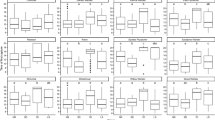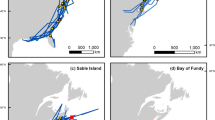Abstract
The rate at which migrant birds replenish their energy stores at intermittent stopovers largely determines overall migration speed, the manner in which migration proceeds and success of migration. In this study, data on the fuel deposition rate (FDR) of three long-distance migrants from 17 ringing sites along their autumn migration route were used to examine: (1) effects of endogenous factors on FDR, and (2) how relationships between exogenous factors and FDR affect the organisation of migration. We developed a model to estimate FDR from retrapped birds which takes into account time of day and various other factors which might influence FDR. The two endogenous factors, moult and current energy stores, generally reduced FDR. This may result in lower departure energy loads and more stopovers than expected from optimal migration theory. Differences between species with respect to seasonal, year-to-year and geographical patterns of FDR could be related to differences in availability and predictability of food resources, and help to explain differences in the organisation of migration. A low FDR in northern and central Europe could be related to low, but predictable, food resources and an early departure during moult of the reed warbler (Acrocephalus scirpaceus); FDRs varying between years were related to large spatial and year-to-year variation in the density of the main prey of the sedge warbler (Acrocephalus schoenobaenus); and a high FDR in the garden warbler (Sylvia borin) was related to abundant food resources, due to a switch from a purely invertebrate diet to a mixed diet including fruits which are abundant over large areas of Europe and north Africa. This study demonstrated that the organisation of migration is the outcome of a complex interplay of the seasonal timing of moult, food availability and predictability and a seasonal switch in diet, and can be modified by individual birds in response to a limited amount of time in which to migrate.
Similar content being viewed by others
Author information
Authors and Affiliations
Additional information
Received: 26 April 1999 / Accepted: 24 September 1999
Rights and permissions
About this article
Cite this article
Schaub, M., Jenni, L. Fuel deposition of three passerine bird species along the migration route. Oecologia 122, 306–317 (2000). https://doi.org/10.1007/s004420050036
Issue Date:
DOI: https://doi.org/10.1007/s004420050036




